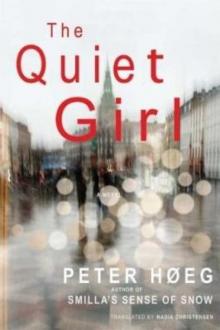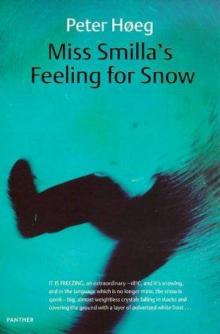- Home
- Peter Høeg
Smilla's Sense of Snow Page 24
Smilla's Sense of Snow Read online
Page 24
Lander, the rich businessman, driven by a desire for excitement and a mysterious sense of gratitude.
That is the beginning of a social cross section of Denmark. The mechanic is the skilled worker, the laborer. Juliane is the dregs. And I—who am I? Am I the scientist, the observer? Am I the one who has been given the chance to get a glimpse of life from the outside? From a point of view made up of equal parts of loneliness and objectivity?
Or am I only pathetic?
In the channel the grease ice is held together with a thin, dark, disintegrating crust of ice, what’s called “rotten ice,” dissolving and crumbling from below. I walk along the dark edge, down toward the White Palace, until I find a floe that’s big enough. I step onto it and then onto the next. There’s a slight movement with the current, down through the harbor, of maybe half a knot, rocking, lethal. I leap the last part of the way from floe to floe. I don’t even get my feet wet.
The windows of the White Palace are dark. The entire complex seems to be in a sleep that also encompasses the walls, the playground, the stairways, the naked trunks of the trees. From the canal I come up behind the bicycle sheds, slowly and cautiously. I stop there.
I look at the parked cars. At the dark entryways. There is no movement. Then I look at the snow. The thin, fine layer of newly fallen snow.
There is no moon, so it takes time before I notice them. A single row of footprints. He came across the bridge and went behind the building. On this side of the playground the footprints are visible. A Vibram sole under a large person. They lead in under the shed roof in front of me, and they don’t come back out.
Then I can feel him. There’s no sound, no smell, nothing to see. But the tracks have made me resonant to his presence, to the certainty of a looming threat.
We wait for twenty minutes. When the cold makes me start shaking I pull away from the wall so I won’t make any noise. Maybe I should give up and go back the way I came. But I stay. I detest fear. I hate being scared. There is only one path to fearlessness. It’s the one that leads into the mysterious center of the terror.
For twenty minutes there is only soundless waiting. At 9° Fahrenheit. My mother could handle that. Most Greenlandic hunters can manage it any time. I can pull it off on rare occasions. For most Europeans it would be unthinkable. They would shift their weight, clear their throat, cough, rustle their overcoat.
The man whose presence I sense less than a yard away must be convinced that he’s alone, that no one can hear or see him. And yet he is as soundless as if he never existed.
But not for one second am I tempted to move, to give in to the cold. Like one long, internal shriek my senses tell me that someone is waiting there. That he’s waiting for me.
I don’t even hear him leave. I close my eyes for a moment because the cold has made them run. When I open them, a shadow has torn away from the shed roof and is moving off. A tall figure with a quick, fluid gait. And above his head, like a halo or a crown, something white, maybe a hat.
There are two ways to tag polar bears. The usual way is to stun them from a helicopter. The machine drops down directly over the bear, you lean out of the cockpit, and the instant that the air pressure from the rotor strikes the animal, it falls to the ground and you shoot.
Then there’s the other method that we used on Svalbard. From a snowmobile—“the Viking way.” You shoot with a custom air rifle made by Neiendamm in southern Jutland. This method requires you to get close, less than fifty yards away. Less than twenty-five is better. The moment the bear stops and turns around, you get a good look at it. Not one of those living carcasses that amuse you at the zoo, but a polar bear, the one from the Greenlandic coat of arms, colossal, three-quarters of a ton of muscle, bone, and teeth. With an extreme, lethal ability to explode. A wild animal that has existed for only 20,000 years, and in that time has known only two types of mammals: its own species and its prey.
I have never missed. We used bullets in which a gas device injected a large dose of Zolatil. The bear fell almost instantaneously. But not for a moment was I free of the panicky, hair-raising fear.
It’s the same feeling now. What is moving away from me is only a shadow, a stranger, a person who is not aware of my presence. But the hair on my skin, which is numb from the cold, is standing on end like spines on a porcupine.
I reach the stairway through the basement rooms. The mechanic’s door is locked, and the tape is in place.
The door of Juliane’s apartment is standing open. As I pass, she comes out onto the stairs.
“You’re going away, Smilla.”
She looks weak and helpless. But I hate her, anyway.
“Why didn’t you tell me about Ving?” I say. “That he came and picked up Isaiah?”
She starts to cry. “The apartment. He gave us the apartment. He’s a big shot with the housing authority. He could take it away again. He said that himself. Aren’t you coming back?”
“Of course I am,” I say.
It’s true. I’ll have to come back. She’s the only thing left of Isaiah. Just as, for Moritz, I’m his only connection with my mother.
I walk up to my own floor. The tape hasn’t been touched. I let myself in. Everything is the way I left it. I gather up only the most essential clothes. They fill two suitcases, which weigh so much that I would have to call a moving van. I try to repack them. It’s difficult, because I don’t dare turn on a light but work by the reflection from the city’s lights on the snow outside. Finally I limit myself to one large duffel bag. But not without heart-rending sacrifices.
Standing in the middle of the room, I take one last look around. I pick up Isaiah’s cigar box and put it in the bag. I say a brief mental farewell to my home.
Then the phone rings.
Of course I should just let it ring. I promised the mechanic not to come up here. And I wouldn’t want to talk to the police. Everything else can wait. I should just let it ring. I have everything to lose and nothing to gain.
I loosen the tape and pick up the receiver.
“Smilla …”
The voice is languid, almost distracted. But at the same time golden and resonant, like in a TV commercial. I have never heard it before. The hairs on the back of my neck stand on end. I know that it belongs to the person who was standing less than a yard away from me only moments ago. I’m absolutely sure of it.
“Smilla … I know you’re there.”
I hear his breathing. Deep, calm. “Smilla …”
I put down the receiver, not on the phone, but on the table. I have to use both hands so I won’t drop it. I sling my bag over my shoulder. No time to change shoes. I race out the door and down the dark stairway, out the front door and along Strand Street, across the bridge, and up Havne Street. We can’t control ourselves every second of our lives. There comes a time, for each of us, when panic takes the upper hand.
Lander is waiting with the engine running. I throw myself into the passenger seat and cling to him.
“This is a good start,” he says.
Slowly I get my breathing down to a tolerable level.
“It was purely a one-time acknowledgment of sympathy,” I tell him. “Don’t let it go to your head.”
I let him drive me all the way up to the house. For tonight, anyway, I’ve lost all desire to be alone in the dark. And I don’t know where else to go. Moritz opens the door himself. Wearing a white terry-cloth robe, white silk shorts, his hair rumpled, his eyes sleepy.
He looks at me. He looks at Lander, who is carrying my bag. He looks at the Jaguar. Amazement, jealousy, old rage, temper, curiosity, and unctuous indignation roam and struggle through his half-asleep brain. Then he rubs the stubble on his face.
“Are you coming in?” he says. “Or should I just hand the money through the mail slot?”
5
The rib bones are the closed ellipses of the planets, with their focus in the sternum, the breastbone, the white center of the photograph. The lungs are the gray shadows of the Milky Way
against the black leaden shield of space. The heart’s dark contour is the cloud of ashes from the burned-out sun. The intestines’ hazy hyperboles are the disconnected asteroids, the vagabonds of space, the scattered cosmic dust.
We’re standing in Moritz’s consultation room at the light box, on which three X-rays have been clipped. In the technical reduction of photon photography it’s more apparent than ever that the human being is a universe, a solar system seen from another galaxy. And yet this person is dead. With a jackhammer someone dug him a grave in the permafrost of Holsteinsborg, put stones on top, and poured cement over it to keep the Arctic foxes away.
“Marius Høeg, dead on the Barren Glacier, Gela Alta, July 1966.”
I am standing with Moritz and forensics expert Dr. Lagermann in front of the light box. Benja is sitting in a wicker chair sucking her thumb.
The floor is yellow marble, the walls are covered with light brown fabric. There is wicker furniture and an examination table painted avocado green and covered with natural-colored leather. There is an original Dalí on the wall. Even the X-ray machine looks as if it feels comfortable with this attempt to make advanced technology seem homey.
This is where Moritz earns a portion of the money which helps to make his later years golden, but at the moment he is working for free. He is examining the X-rays which Lagermann, in defiance of six paragraphs of the law, has taken from the archives of the Institute of Forensic Medicine.
“The report from the expedition in ’66 is missing. It has simply been removed. Damn.”
I told Moritz that they are looking for me and that I have no intention of turning myself in to the police. He detests illegalities but he acquiesces because, with or without permission from the police, it’s better for me to be here than not.
I told him that I’m going to have a visitor and that we will need the light box in his clinic. His clinic is his inner sanctum, as private as his investments and his bank accounts in Switzerland, but he agrees.
I said that I wouldn’t tell him what it was all about. He acquiesces. He’s trying to pay back some of his debt to me. It’s thirty years old and fathomless.
Now that Lagermann has arrived and unpacked and hung up the pictures with little clips, the door opens, and Moritz slouches in.
Standing there in front of us he is three people in one.
He is my father, who still loves my mother and maybe me as well, and is now sick with anxiety that he can’t control.
He is the great doctor, M.D., and international injection star who has never been excluded, always the one who knew things before anyone else did.
And he is the little boy who has been shut out of the room in which something is happening that he’s dying to take part in.
It’s the latter person that I, on sudden impulse, allow into the room and whom I introduce to Lagermann.
Of course he knows my father; he shakes his hand and smiles broadly at him; he has met him two or three times before. I should have realized what would happen now: that Lagermann would pull him over to the light box.
“Just have a look at this,” he says. “Because there’s something here that’ll surprise the hell out of you.”
The door opens and Benja pads in. With her woolen socks and her turned-out prima-donna feet and her demand for undivided attention.
The two men are glued to the transparent star chart on the box. They are explaining it to me. But their words are directed at each other.
“There are few dangerous bacteria in Greenland.”
Lagermann doesn’t know that Moritz and I have forgotten more about Greenland than he will ever learn. But we don’t interrupt him.
“It’s too cold. And too dry. That’s why poisoning from spoiled food is extremely rare. With the exception of one kind: botulism, anaerobic bacteria that produce a very dangerous form of meat poisoning.”
“I’m a lactovegetarian,” says Benja.
“The report is in Godthåb, with a copy in Copenhagen. It says that they found five people on the same day, August 7, 1991. Healthy young people. Botulism, Clostridium botulinum, is anaerobic, just like the tetanus bacteria. And not dangerous in and of itself. But its waste products are exceedingly toxic. They attack the peripheral nervous system where the nerves innervate the muscle fibers. Paralyze the lungs. Just before death, it’s spectacular, of course. Hypoventilation, acidosis like crazy. The person turns blue in the face. But when it’s over, there’s not a trace. Naturally the livores are slightly darker, but hell, they are with a heart attack, too.”
“So there is nothing externally visible?” I ask.
He shakes his head. “Nothing. Botulism is determined by a process of elimination. Something you come to suspect because you can’t find any other cause of death. Then you take a blood sample. And samples of the food under suspicion. You send them to the Serum Institute. Queen Ingrid’s Hospital in Godthåb has a medical laboratory, of course. But no facilities to trace the less common toxins. So blood samples were sent to Copenhagen. In the samples they found the toxin from botulinum.”
He takes out one of his big cigar matches. Moritz’s eyebrows shoot up on his brow. It’s forbidden, under penalty of death, to smoke in the clinic. Smokers are shown to the smoking salon, which means a walk in the garden. Even there he doesn’t like it much. He thinks that the sight of someone smoking, even from a distance, might affect his golf swing. It was one of his few, great, miraculous triumphs over my mother that he got her to go outside to smoke in Qaanaaq. It was one of his many defeats that she smoked indoors in the summer tent at Siorapaluk.
With the unsulfured end of the match Lagermann points at a row of tiny numbers on the bottom edge of the X-ray. “X-rays cost a damn fortune. We only use them to search for hardware that has been stuck into people. No pictures were taken in ’91. It wasn’t thought necessary.”
He takes out a cellophane-wrapped cigar from his breast pocket.
“You’re not allowed to smoke in here,” says Benja.
He gives her a preoccupied look. Then he gently taps the photo with the cigar.
“But in ’66 they had to take pictures. There was some doubt about identification. They were severely maimed by the explosion. There was nothing to do but take X-rays. To look for old bone fractures and the like. The negatives were supposedly sent around to all the doctors in Greenland. Along with a full dental shot of what was left of their teeth.”
It’s not until now that I realize there are no thighbones beneath the pelvis in the X-ray.
Lagermann carefully places two more negatives next to the first one. In one of them almost the entire spine is intact. The other is a chaos of bone fragments and dark shadows, a pulverized universe.
“These prompt various professional questions. Such as the location of the bodies in relation to the detonation. It looks as if they were sitting right on top of the charge. That it was not—as is normal when you use plastic explosives on rock or ice—placed in a bored-out channel, or kneaded to an upside-down can, which concentrates the explosion in one particular spot. It practically blew up right under their ass, so to speak. Which rarely happens when professionals are involved.”
“I’m leaving,” says Benja. But she stays in her chair.
“All of this is speculation based on very little evidence, of course. But this isn’t.”
He hangs up two larger X-rays under the first ones. “Enlargements from the negative of these areas.”
He points with the cigar. “You can see the remains of the liver, the lower esophagus, and the stomach. The bottom rib has gotten stuck here, right above the vertebra lumbalis, which is here. This is the heart. Here it’s damaged, there it’s intact. Do you notice anything?”
To me it seems a chaos of black and gray nuances. Moritz leans forward. Curiosity wins out over vanity. From his inside pocket he takes out the glasses which only we, the women in his life, have ever seen him wear. Then he puts a fingernail on each picture.
“There.”
Lagerm
ann straightens up.
“Yes,” he says, “that’s the spot. But what the hell is it?”
Moritz picks up a magnifying glass from an aluminum tray. Even when he points it out, I don’t understand. Only when he shows it to me on the second negative can I make it out. Just like in glaciology. One occurrence is an accident. It’s the repeat occurrence that creates a structure.
It’s a needle-thin, whitish line, uneven, crooked. It wanders up along the smashed vertebrae, disappears at the ribs, reappears at the tip of one lung, vanishes, and shows up again near the heart, outside and partly inside of it, in the large ventricle, like a white thread of light.
Lagermann points at the second X-ray. Through the liver, into the left kidney.
They stare through the magnifying glass.
Then Moritz turns around. He picks up a shiny, thick journal from his desk.
“Nature,” he says. “A special issue from 1979. Which you, Smilla, directed my attention to.”
There’s a photograph on the right-hand side. An X-ray photo, but using a technique that makes the soft organs visible, too, so that the body almost imperceptibly merges into the skeleton.
“This,” says Moritz, “is a man from Ghana.”
He points with his fountain pen along the left side of the photograph. There is a light winding line moving from one hip up through the abdominal cavity.
“Dracunculus,” he says. “Guinea worm. Transmitted via Cyclops water fleas, in the drinking water. Can also bore its way through the skin. A truly nasty parasite. Up to three feet long. Works its way through the body with a speed of up to half an inch a day. Finally sticks its head out through the thigh. That’s where the Africans catch it and roll it up around a stick. Every day they wind up a few more inches. It takes a month to get it out. That month and the months before are one continuous period of suffering.”
“That’s gross,” says Benja.

 The Woman and the Ape
The Woman and the Ape Smilla's Sense of Snow
Smilla's Sense of Snow Borderliners
Borderliners The Susan Effect
The Susan Effect The History of Danish Dreams
The History of Danish Dreams The Elephant Keepers' Children
The Elephant Keepers' Children The Quiet Girl - Peter Hoeg
The Quiet Girl - Peter Hoeg Smilla's Sense of Snow aka Miss Smilla's Feeling for Snow
Smilla's Sense of Snow aka Miss Smilla's Feeling for Snow